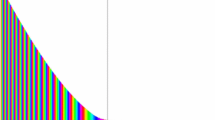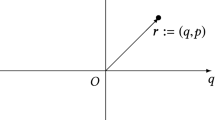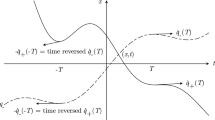Abstract
We show how trajectories can be reintroduced in quantum mechanics provided that its spatial continuum is modelled by a variable real number (qr-number) continuum. Such a continuum can be constructed using only standard Hilbert space entities. In this approach, the geometry of atoms and subatomic objects differs from that of classical objects. The systems that are non-local when measured in the classical space-time continuum may be localized in the quantum continuum. We compare trajectories in this new description of space-time with the corresponding Bohmian picture.
Similar content being viewed by others
References
Adelman, M., Corbett, J.V.: Appl. Categ. Struct. 3, 79 (1995)
Adelman, M., Corbett, J.V.: Quantum mechanics as an intuitionistic form of classical mechanics. In: Proceedings of the Centre Mathematics and Its Applications, pp. 15–29. ANU, Canberra (2001)
Bell, J.S.: Speakable and Unspeakable in Quantum Mechanics, pp. 117–118. Cambridge University Press, Cambridge (1993)
Bitbol, M.: Are there particles and quantum jumps? In: Nair, R. (ed.) Mind, Matter and Mystery, pp. 52–53. Scientia, New Delhi (2001)
Bohm, D.: Quantum Theory. Prentice Hall, Englewood Cliffs (1951)
Bohm, D.: A suggested interpretation of the quantum theory in terms of hidden variables. Phys. Rev. 85, 166 (1952)
Bohr, N.: Ueber die Antwendung der Quantentheorie auf den Atombau. I. Die Grundpostulate der Quantentheorie. Z. Phys. 13, 118 (1923)
Corbett, J.V.: The mathematical structure of quantum-real numbers. Preprint, arXiv:0905.0944 v1 [math-ph], 7 May 2009
Corbett, J.V., Durt, T.: Quantum mechanics interpreted in qr-numbers (2002). arXiv:quant-ph/0211180
Corbett, J.V., Durt, T.: Quantum mechanics as a space-time theory (2005). Preprint arXiv:quant-ph/0512220 v1, 23 Dec 2005
Corbett, J.V., Durt, T.: Collimation processes in quantum mechanics interpreted in quantum real numbers. In: Studies in History and Philosophy of Modern Physics, vol. 40, pp. 68–83 (2009)
da Costa, N.C.A., Krause, D., French, S.: The Schroedinger problem. In: Bitbol, M., Darrigol, O. (eds.) Erwin Schroedinger, Philosophy and the Birth of Quantum Mechanics, pp. 450–453. Frontieres, Paris (1992)
Dieks, D.: Space and time in particle and field physics. Stud. Hist. Philos. Mod. Phys. 32, 217–241 (2001)
Durt, T.: From quantum to classical, a toy model. PhD thesis, Vrije Universiteit Brussel (1996)
Durt, T., Pierseaux, Y.: Bohm’s interpretation and maximally entangled states. Phys. Rev. A 66, 052109–052120 (2002)
Einstein, A., Podolsky, B., Rosen, N.: Can quantum-mechanical description of physical reality be considered complete? Phys. Rev. 47, 777 (1935)
Filk, T.: Relational interpretation of the wave function and a possible way around Bell’s theorem. Int. J. Theor. Phys. 45(6), 1166–1180 (2006)
Hartshorne, R.: Geometry: Euclid and Beyond. Springer, New York (2000)
Jauch, J.M.: Foundations of Quantum Mechanics, pp. 275–280. Addison-Wesley, Reading (1968)
Lévy-Leblond, J.-L.: Galilei group and Galilean invariance. In: Loebl, E.M. (ed.) Group Theory and Its Applications, pp. 221–299. Academic Press, New York (1971)
MacLane, S., Moerdijk, I.: Sheaves in Geometry and Logic. Springer, New York (1994)
Mandel, L.: Indistinguishability in One-Photon and Two-Photon Interference. Founds. Phys. 25(2), 211–228 (1995)
Mulvey, C.: Intuitionistic algebra and representation of rings. Mem. Am. Math. Soc. 148, 3–57 (1974)
Reed, M., Simon, B.: Functional Analysis. Methods of Modern Mathematical Physics, vol. 1, p. 199. Academic Press, New York (1972)
Stout, L.N.: Cah. Topol. Geom. Differ. XVII, 295 (1976)
Weigert, S.: Quantum time evolution in terms of nonredundant expectation values. Phys. Rev. Lett. 84(5), 802–805 (1999)
Author information
Authors and Affiliations
Corresponding author
Rights and permissions
About this article
Cite this article
Corbett, J., Durt, T. Spatial Localization in Quantum Theory Based on qr-numbers. Found Phys 40, 607–628 (2010). https://doi.org/10.1007/s10701-010-9424-4
Received:
Accepted:
Published:
Issue Date:
DOI: https://doi.org/10.1007/s10701-010-9424-4




